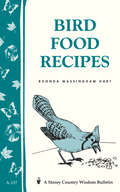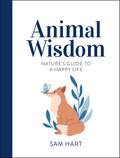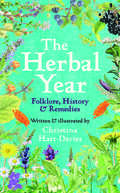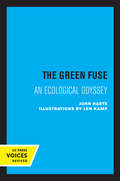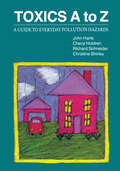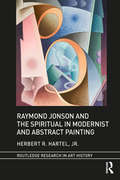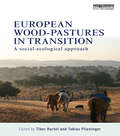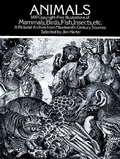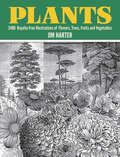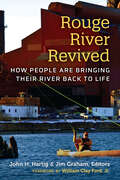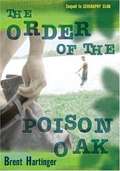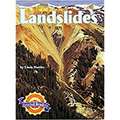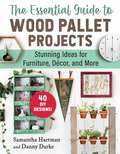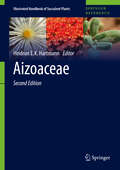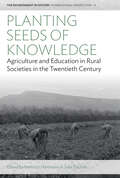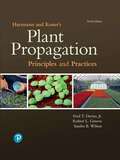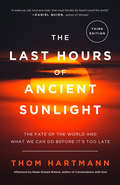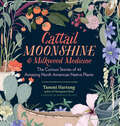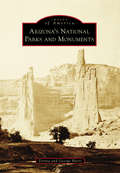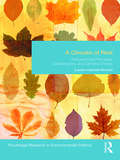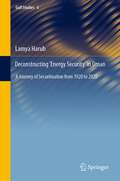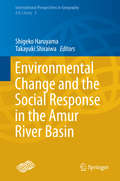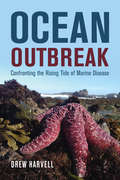- Table View
- List View
Bird Food Recipes: Storey Country Wisdom Bulletin A-137 (Storey Country Wisdom Bulletin Ser.)
by Rhonda Massingham HartSince 1973, Storey's Country Wisdom Bulletins have offered practical, hands-on instructions designed to help readers master dozens of country living skills quickly and easily. There are now more than 170 titles in this series, and their remarkable popularity reflects the common desire of country and city dwellers alike to cultivate personal independence in everyday life.
Animal Wisdom: Nature's Guide to a Happy Life
by Sam HartSelf-care gone wild Slow down like a sloth, stretch like a cat, breathe deep like a whale and have the confidence of a lion. When life gets you down, lift your spirits with these tiny tips and helpful hints from our friends in the animal kingdom.
The Herbal Year: Folklore, History and Remedies
by Christina Hart-DaviesAn enchanting, beautifully illustrated guide to seasonal plants—showing the long history of herbal remedies and their uses today“[A] charming almanac. . . . Hart-Davies, a writer and botanical illustrator whose watercolors enliven her book, . . . offers a lively combination of folk history and modern science; they overlap in intriguing ways.”—Priscilla M. Jensen, Wall Street Journal From sweet violets in spring to rosemary in winter, via marigolds, sage, elderberries, and hops, every season has its own bounty of herbs and plants. Christina Hart-Davies presents a delightful guide to common plants as they appear throughout the year. Drawing on writers, storytellers, and poets from across the centuries, she examines the long history of herbal remedies. She shows how plants have been used for healing and unearths the stories and beliefs that surround them—including simple recipes for use at home. Fully illustrated with exquisitely detailed watercolours, this is an inspirational guide to exploring our age-old relationship with plants. Readers will discover the hidden secrets of the plants that surround us and, through this, will be able to reconnect with our place in nature. We have relied on plants throughout our history. We still do, and, with luck, we always will.
The Green Fuse: An Ecological Odyssey
by John HarteA widely respected ecological scientist and activist draws on the poet's image and his own environmental research to demonstrate the many interconnections among the world's ecosystems. John Harte takes us from Alaskan salmon runs and the Florida everglades to South Pacific coral reefs and the bleak Tibetan plateau. The result is that rare book that bridges the cultures of science and art. Lyrical, vivid portraits of natural wonders and the threats to them are combined with precise scientific accounts of natural processes and their disturbances. The Green Fuse will show nonscientists the fascination of ecological detective work and renew scientists' love for the beauty of the world under their microscopes. Harte's stories illuminate, without sermonizing, the damage to natural systems brought about by technological hubris and calculated political ruthlessness. "The green fuse" symbolizes the basic unity behind natural diversity. But a fuse may also be the weak link in an overloaded system or the slow burning wick on an ecological bomb. As The Green Fuse reminds us, the energies that created human liberation from nature can also be those that lead to the human destruction of nature. This title is part of UC Press's Voices Revived program, which commemorates University of California Press’s mission to seek out and cultivate the brightest minds and give them voice, reach, and impact. Drawing on a backlist dating to 1893, Voices Revived makes high-quality, peer-reviewed scholarship accessible once again using print-on-demand technology. This title was originally published in 1993.
Toxics A to Z: A Guide to Everyday Pollution Hazards
by John Harte Cheryl Holdren Richard Schneider Christine ShirleyToxics A to Z features and alphabetical listing of over 100 toxics, identifying . . .What they areHow they are measuredWhere they are foundThe symptoms of exposureWhat their known risks areHow we can lessen or avoid those risksAn easy-to-use Cross-Reference Guide to help readers identify toxics in 18 major groups, including indoor and outdoor air pollutants, household items, and lawn and garden productsA glossary of terms, explanation of abbreviations, and listing of sources for further help and information
Raymond Jonson and the Spiritual in Modernist and Abstract Painting (Routledge Research in Art History)
by Herbert R. Hartel, Jr.This is the most thorough and detailed monograph on the artwork of Raymond Jonson. He is one of many artists of the first half of the twentieth-century who demonstrate the richness and diversity of an under-appreciated period in the history of American art. Visualizing the spiritual was one of the fundamental goals of early abstract painting in the years before and during World War I. Artists turned to alternative spirituality, the occult, and mysticism, believing that the pure use of line, shape, color, light and texture could convey spiritual insight. Jonson was steadfastly dedicated to this goal for most of his career and he always believed that modernist and abstract styles were the most effective and compelling means of achieving it.
European Wood-pastures in Transition: A Social-ecological Approach
by Tibor Hartel Tobias PlieningerWood-pastures are important elements of European cultural identity and have an exceptional ecological value, yet they are in decline all over Europe. The structure of wood-pastures is strongly influenced by grazing and multiple other land uses and by local and regional environmental conditions. This book examines the diverse expressions of wood-pastures across Europe. It provides a new perspective, using a social-ecological framework to explore social and ecological values, governing institutions, threats and conservation approaches. It explores the major drivers of decline, which are shown to be related to accelerated cultural, institutional and developmental changes occurring across Europe over the past century. Case studies are included from North-Western, Southern, and Eastern Europe. Written by renowned scholars and conservationists, the book contributes to developing better, locally adapted conservation policies and management approaches for wood-pastures.
Animals: 1,419 Copyright-Free Illustrations of Mammals, Birds, Fish, Insects, etc (Dover Pictorial Archive)
by Jim HarterSelected for its visual impact and ease of use, this outstanding collection of wood engravings presents over 1,000 species of animals in extremely lifelike poses. Includes many different versions of familiar mammals, birds, reptiles, amphibians, fish, insects, and other invertebrates such as spiders, crabs, squid, earthworms, and more. Captions provide modern common-name identifications.
Plants: 2,400 Royalty-Free Illustrations of Flowers, Trees, Fruits and Vegetables
by Jim HarterHundreds of plant species -- from lilies, lichens, and palms to mushrooms, mosses, and maples -- supplemented by appendices on edible plants, medicinal herbs, and plants used in decoration and in graphic design. Indispensable source of inspiration and royalty-free graphics for designers and artists; a captivating compendium for botanists, gardeners, and collectors of old engravings.
Rouge River Revived: How People Are Bringing Their River Back to Life
by John H. Hartig Jim GrahamThe Rouge River is a mostly urbanized watershed of about 500 square miles populated by nearly 1.4 million people. While not geographically large, the river has played an outsized role in the history of southeast Michigan, most famously housing Ford Motor Company’s massive Rouge Factory, designed by architect Albert Kahn and later memorialized in Diego Rivera’s renowned “Detroit Industry” murals. In recent decades, the story of the Rouge River has also been one of grassroots environmental activism. After pollution from the Ford complex and neighboring factories literally caused the river to catch on fire in 1969, community groups launched a Herculean effort to restore and protect the watershed. Today the Rouge stands as one of the most successful examples of urban river revival in the country. Rouge River Revived describes the river’s history from pre-European times into the 21st century. Chapters cover topics such as Native American life on the Rouge; indigenous flora and fauna over time; the river’s role in the founding of local cities; its key involvement in Detroit’s urban development and intensive industrialization; and the dramatic clean-up arising from citizen concern and activism. This book is not only a history of the environment of the Rouge River, but also of the complex and evolving relationship between humans and natural spaces.
The Order of the Poison Oak
by Brent HartingerSummer camp is different from high school. Something about spending the night. Things happen. Geography Club's Russel Middlebrook is back, and he and his friends are off to work as counselors at a summer camp. Brent Hartinger's third novel is the story of Indian legends, skinny-dipping in moonlit coves, and passionate summer romance. It's also the story of Russel's latest club, the "Order of the Poison Oak", a secret society dedicated to helping its members see life's hidden beauty and accept its sometimes painful sting.
Danger--Landslides! (Houghton Mifflin Harcourt Vocabulary Readers #Leveled Reader: Level: 4, Theme: 6.2)
by Linda HartleyIntroduces children to landslides.
Landslides (Leveled Readers 4.6.2)
by Linda HartleyWhat happens when tons of rocks and dirt slide down a mountain?
¡No pises ese insecto! (¡Arriba la Lectura!, Level J #77)
by Holly Hartman¿Sabías que algunos insectos son muy útiles? Descubre por qué las hormigas, las mariquitas y otros insectos ayudan a que la vida sea mejor. NIMAC-sourced textbook
The Essential Guide to Wood Pallet Projects: 40 DIY Designs—Stunning Ideas for Furniture, Decor, and More
by Samantha Hartman Danny DarkeRustic meets modern with this charming do-it-yourself guide. Here are 40 easy-to-follow designs, ranging from coffee tables and wine racks to decorative wall art, all with step-by-step and clear full-color photographs. Perfect for those looking for simple and creative ways to decorate their homes. Wooden shipping pallets have found an unlikely second life: beautiful, handcrafted home décor without the designer price. The DIY market has long been drawn to refurbishing furniture and interior design on a budget, but easily accessible wood pallets have opened up all-new and inspiring ways to personalize a home in an eco-friendly, low-cost way. Beginner and veteran DIYers alike can take delight in crafting various furniture and décor that will impress and inspire without breaking the bank. Included within are instructions on how to make the following projects: Hanging ShelfDeck ChairWall-Hanging Mason Jar OrganizerPallet-Mounted Bottle OpenerWall-Mounted Coat RackSconcesDoor Handle Serving TrayPallet Arrow Wall ArtOutdoor Flower BoxFlower Arrangement CenterpieceClothes Pin Picture FrameRustic NightstandShabby Chic ToolboxFarmhouse Spice RackFarmhouse Wall ClockTealight Candle HoldersAnd more! With wooden pallets, the scope of the project is boundless, and warehouses and stores are happy to give them away for free. What was once a scavenger hunt and test of skill for experienced DIYers can now be an easy weekend project for even the newest of crafters. Take pride in creating imaginative home stylings with found and reclaimed materials that will help the environment, save you money, and make your home even more lovely!
Aizoaceae: Aizoaceae F-z (Illustrated Handbook of Succulent Plants)
by Heidrun E. K. HartmannAbout 15 years after the first edition of the Handbook of Aizoaceae, a wealth of changes can be reported for the family Aizoaceae, and this second edition brings a completely new survey over all taxonomic units from subfamilies down to species and subspecies; each critically examined. Of the presently known 2956 species, 1594 have been accepted and are described here, arranged in 147 genera. Six genera have been newly described since 2001, namely Brianhuntleya, Hammeria, Knersia, Phiambolia, Ruschiella, and Volkeranthus, and only one has been placed newly into synonymy (Caulipsilon). All synonymous genus names are treated with the valid genus names. Preliminary molecular studies are referred to, for which different groups of markers at different levels like species, genera, subgenera, and further ranks have been used. The basic division into four subfamilies is supported by more recent studies, yet with some genera being shifted. Furthermore, the geographical distribution of each genus is shown on one map each: either worldwide, or restricted to Southern Africa. For these latter, the main rainfall seasons are delimited by blue lines in order to offer also parameters for cultivation. This second edition provides a comprehensive list of the latest taxonomy including the updated relevant plant data. Following an introduction to the leaf-succulent family Aizoaceae, including keys to the subfamilies and genera, all genera with keys to the subgenera and succulent species are described in detail.
Planting Seeds of Knowledge: Agriculture and Education in Rural Societies in the Twentieth Century (Environment in History: International Perspectives #24)
by Heinrich Hartmann Julia TischlerIn the late nineteenth and early twentieth centuries, agricultural practices and rural livelihoods were challenged by changes such as commercialization, intensified global trade, and rapid urbanization. Planting Seeds of Knowledge studies the relationship between these agricultural changes and knowledge-making through a transnational lens. Spanning exchanges between different parts of Europe, North and South America, the Indian subcontinent, and Africa, the wide-reaching contributions to this volume reform current historiography to show how local experiences redefined global practice.
Hartmann and Kester's Plant Propagation: Principles and Practices
by Hudson Hartmann Dale Kester Fred Davies Robert Geneve Sandra WilsonFor all undergraduate courses in plant propagation at the two-year and four-year colleges and universities. <p><p>The world standard for plant propagation and horticulture for over 50 years, Hartmann and Kester’s Plant Propagation continues to be the field’s most complete, up-to-date text on plant propagation. It now contains color figures throughout, promoting learning and making it an even more useful working text and reference. It also contains extensive updates reflecting the latest commercial techniques and understanding of propagation biology. Like previous editions, it is organized into paired chapters on principles and practices, so it can easily be adapted for teaching courses that cover only practical topics, and for courses that also cover conceptual issues.
The Last Hours of Ancient Sunlight: The Fate of the World and What We Can Do Before It's Too Late
by Thom HartmannWhile everything appears to be collapsing around us -- ecodamage, genetic engineering, virulent diseases, the end of cheap oil, water shortages, global famine, wars -- we can still do something about it and create a world that will work for us and for our children's children. The inspiration for Leonardo DiCaprio's web movie Global Warning, The Last Hours of Ancient Sunlight details what is happening to our planet, the reasons for our culture's blind behavior, and how we can fix the problem. Thom Hartmann's comprehensive book, originally published in 1998, has become one of the fundamental handbooks of the environmental activist movement. Now, with fresh, updated material and a focus on political activism and its effect on corporate behavior, The Last Hours of Ancient Sunlight helps us understand--and heal--our relationship to the world, to each other, and to our natural resources.
Cattail Moonshine & Milkweed Medicine: The Curious Stories of 43 Amazing North American Native Plants
by Tammi Hartung Panayoti Kelaidis2016 Silver Nautilus Book Award Winner History, literature, and botany meet in this charming tour of how humans have relied on plants to nourish, shelter, heal, clothe, and even entertain us. Did you know that during World War II, the US Navy paid kids to collect milkweed’s fluffy white floss, which was then used as filling for life preservers? And Native Americans in the deserts of the Southwest traditionally crafted tattoo needles from prickly pear cactus spines. These are just two of the dozens of tidbits that Tammi Hartung highlights in the tales of 43 native North American flowers, herbs, and trees that have rescued and delighted us for centuries.
Arizona's National Parks and Monuments
by George Hartz DonnaArizona's 20 national parks and monuments celebrate the natural wonders and rich heritage of Arizona, preserved through the efforts of countless citizens and the American Antiquities Act of 1906. Aggressively implemented by eight US presidents, this legislation permits the president to unilaterally proclaim sites as national monuments without congressional action. The Antiquities Act was applied in Arizona 23 times, more so than any other state in the union. Using more than 200 historical photographs, many of which have never been published, this book contains the stories of the creation of each of Arizona's national parks and monuments, emphasizing the importance of the landscape and cultural heritage to Arizona's identity.
A Climate of Risk: Precautionary Principles, Catastrophes, and Climate Change (Environmental Politics)
by Lauren Hartzell-NicholsWe are living in a climate of risk. Our way of life imposes risks on ourselves and others. We are causing climatic changes that have the potential to change radically the conditions under which both we – the present generation – and future generations will live. While we are now quite certain that climate change is happening, we are unsure of exactly what will happen and when, given different emissions and policy scenarios. We are therefore in a position where we must decide what to do about the risks climate change threatens in the face of a range of uncertainties In this book, Lauren Hartzell-Nichols provides guidance in the face of this uncertainty by offering an in-depth discussion of how and why we ought to take a precautionary approach to climate policy, namely by appeal to a Catastrophic Precautionary Principle and Catastrophic Precautionary Decision-Making Framework. By examining the way in which climate change is harmful, Hartzell-Nichols shows how precaution does have a meaningful role to play in moving climate policy forward if we reconsider what precaution is about before too quickly appealing to precaution as a reason or justification for action. A Climate of Risk takes a philosophically grounded, interdisciplinary approach that will appeal to a broad scholarly and policy-oriented audience. Hartzell-Nichols’s reinterpretation of the precautionary principle enables precaution to be more effectively leveraged as a driver of action on climate change.
Deconstructing ‘Energy Security’ in Oman: A Journey of Securitisation from 1920 to 2020 (Gulf Studies #6)
by Lamya HarubThis book makes a substantial and timely contribution to discussions on energy security in Oman, providing a systematic analysis of energy security in Oman from 1920 to 2020. It is particularly relevant in light of the recent global geopolitics of the Gulf particularly, and the Middle Eastern region broadly, as well as connecting to current climate change research and debates. Combining a political sociological account with postcolonial concepts within a theoretical and empirical exploration of energy politics, the book weaves a study of energy security into the historical and contemporary development of political, economic, security, and social structures in Oman. Including interviews with Omani and Oman-based practitioners, as well as grounded in historical documents which include Arabic-language sources, this book evaluates the energy question beyond the typical economic perspective, considering socio-political opportunities and challenges. It also makes economic-related recommendations in tandem with rentier state theory. Unlike the dominant accounts of energy security in Oman, this book sets itself apart by moving away from utilising liberal and realist approaches for its analysis and engages systematically with critical security studies to introduce a non-Eurocentric perspective to the arena. Of interest to scholars in Middle Eastern history, energy security, and security studies, this book assumes an important place in the critical literature on the Gulf, particularly within environmental studies and energy policy literature.
Environmental Change and the Social Response in the Amur River Basin
by Shigeko Haruyama Takayuki ShiraiwaThis book features research on historical land use and land cover in the Amur River Basin, which are important not only for residents there but also for those affected by its material and water cycles. Land use and land cover are affected by natural and human interactions over long and short timescales. The authors address historical changes in the land cover analysis of the Amur. The Amur region of Russia, land cover change analysis of the Amur, wetland, and flooding of the Amur provide evidence of land cover change. Changes of wetland and floodplain sedimentation processes demonstrate the influences of land cover change on fluvial environment, which are discussed with geomorphology. Water chemistry is showing the physical dimension of the geography of the Amur. The development process of timber harvesting in the Khabarovsk area and land use dynamics in the twentieth century are important evidence of development. The Amur poses an essential question: how can we manage a transboundary watershed without disturbing terrestrial and marine ecosystems for future generations? This book provides essential information for geographers about this relatively unknown region.
Ocean Outbreak: Confronting the Rising Tide of Marine Disease
by Drew HarvellThere is a growing crisis in our oceans as rates of infectious disease outbreaks are on the rise. Marine epidemics have the potential to cause a mass die-off of wildlife from the bottom to the top of the food chain, impacting the health of ocean ecosystems as well as lives on land. Fueled by sewage dumping, unregulated aquaculture, and drifting plastic in warming seas, ocean outbreaks are sentinels of impending global environmental disaster. Ocean Outbreak follows renowned scientist Drew Harvell and her colleagues as they investigate how four iconic marine animals—corals, abalone, salmon, and starfish—have been devastated by disease. Based on over twenty years of research, this firsthand account of the sometimes creeping, sometimes exploding impact of disease on our ocean’s biodiversity ends with a hopeful message. Through policy changes and the implementation of innovative solutions from nature, we can reduce major outbreaks, save some ocean ecosystems, and protect our fragile environment.
